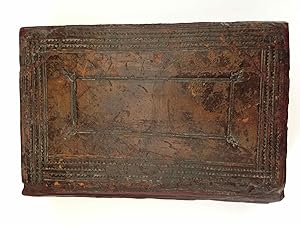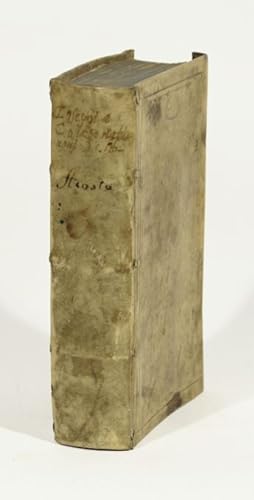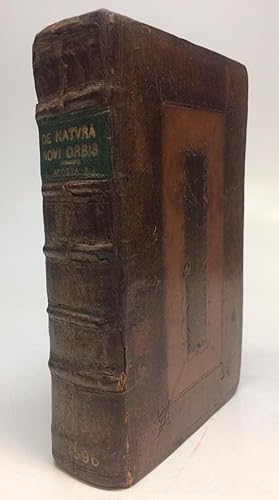natura novi orbis (5 Ergebnisse)
Produktart
- Alle Produktarten
- Bücher (5)
- Magazine & Zeitschriften
- Comics
- Noten
- Kunst, Grafik & Poster
- Fotografien
- Karten
-
Manuskripte &
Papierantiquitäten
Zustand
- Alle
- Neu
- Antiquarisch/Gebraucht
Einband
- alle Einbände
- Hardcover (4)
- Softcover
Weitere Eigenschaften
- Erstausgabe (2)
- Signiert
- Schutzumschlag
- Angebotsfoto (3)
Land des Verkäufers
Verkäuferbewertung
-
De natura novi orbis et de promulgatione Evangelii apud babaros
Verlag: officina Birckmannica, Cologne, 1596
Anbieter: Sokol Books Ltd. ABA ILAB, London, Vereinigtes Königreich
Hardcover. Zustand: Good. 8vo, pp. [16], 581, [3]. Roman letter, little italic. Jesuit device on title; slightly yellowed, occasional oil mark in margins; tiny burn mark affecting one letter on p. 1 and 373; few unprinted words completed in contemporary manuscript and later pencil at bottom of pp. 126 and 274. A good copy, in an early seventeenth-century English brown calf, blind-tooled plain style, probably Cambridge, multiple ruled borders with saw tooth edge, double fillet, central undecorated frame with fleurons at corners; a bit scratched and worn; rebacked, spine part remounted, a.e.r.; pastedowns from an early Roman letter edition of the King James Bible (2nd Maccabees, III, 1-21 and III, 25-40; IV, 1-2). Third unaugmented edition of these pioneering treatises on the geography, anthropology and evangelisation of South America, previously published in Salamanca in 1588/1589 and 1595. José de Acosta (1540-1600) was among the first Jesuit missionaries to embark for the Spanish New World. He spent much of his life in Peru. The main settlement of the order was at that time in the village of Juli, on Lake Titicaca. Here, a college was set up to study the languages of the natives, while the newly-funded Jesuit printing press issued the first printed book of the Americas in 1577. Later, Acosta moved to Lima and taught theology at the university. In the Third Council of Lima (1582-1583) reorganising the American church, Acosta took a very active part and became its official historian. Following an adventurous journey through Mexico, in 1587 he head back to Spain, where he was appointed head of the Jesuit college in Valladolid and later Salamanca. A prolific writer, he is mostly famous for his very successful Historia natural y moral de las Indias. This knowledgeable, realistic and detailed description of the New World was sought after and soon translated into Italian, French, German, Dutch and English. The Natura novi orbis opening this edition represents the early draft of the Historia. In it, Acosta provided the first account of altitude sickness, which affected him while crossing the Andes. He also divided the Amerindians into three categories, acknowledging the Incas and Aztecs as fairly advanced societies in the civilisation process. The second part comprises a very innovative essay on evangelisation. Acosta struggles to demonstrated to his contemporaries that Amerindians were part of the original God s plan for mankind and thus were not inferior creatures undeserved of being Christianised and saved. In grounding his argument, the idea that the first inhabitants of America migrated from the biblical world (specifically from Asia), played a crucial role. Indeed, he was the first writer to postulate the existence of a land bridge at the northern or southern extremities of the two continents, long before the discovery of the Bering Strait. In his missionary zeal, Acosta was much concerned with the preparation and morality of priests, who he encouraged to study the aboriginal languages as an essential part of their duties. One of the earliest writers who have treated philosophically of America and its production. J. Sabin, A Dictionary of Books Related to America, I, p. 17. BM STC Ger., p. 2; Adams, A 124; Brunet, I, 41; Graesse, I, 15; Leclerc, 4; Palau y Dulcet, I, 1979; Sabin, I, 120. Not in JFB nor in Alden. Latin.
-
De natura novi orbis libri duo. Et de promulgatione evangelii apud barbaros, sive, de procuranda indorum salute, libri sex.
Verlag: Köln, Birckmann für Arnold Mylius, 1596., 1596
Anbieter: Versandantiquariat Wolfgang Friebes, Graz, Österreich
Erstausgabe
Zustand: 0. Erste in Deutschland gedruckte, insgesamt zweite Ausgabe dieses interessanten Werkes über die frühe Geschichte der Ureinwohner Perus und Mexikos (die erste Ausgabe war 1589 in Salamanca in zwei Druckvarianten erschienen). Der Autor weilte insgesamt 17 Jahre in Amerika, davon fünf Jahre als Missionar in Peru, später für mehr als zwei Jahre in Mexiko. - This is one of the most celebrated early works on America. It is especially important for its particulars concerning the state of South America at that time, ad the early history of the Indians of Peru and Mexico [.]. He was a carefull and accurate observer of all that he saw" (Cox). - Einband fleckig u. etw. berieben. Schließbänder fehlen. Titel m. Bibl.-Stempel u. kl. altem Namenszug. Die ersten u. letzten Bll. mit kl. (Tinten-?)Fleck im weißen unteren Rand. Tlw. kl. Wurmspuren (meist im weißen Rand). Unterschiedlich gebräunt bzw. (stock-)fleckig. - VD16, A 119; Adams A 124; Alden I, 227; BM STC, German Books 2; Cox II, 225; De Backer/S. I, 34, 4; IA 100.460; Palau 1979; Sabin 120; Streit I, 212. la Gewicht in Gramm: 500 8°. Titel m. Holzschn.-Vignette. Mit einigen Holzschn.-Vignetten u. -Initialen im Text. 8 Bll., 581 S., Pgmt. d. Zt. m. durchzogenen Bünden, handschriftl. Rückentitel u. dreiseitigem Farbschnitt.
-
Iosephi Acosta, Societatis Iesu, De Natura Novi Orbis Libri Duo. Et de Promulgatione Evangelii apud Barbaros, sive, De procuranda Indorum salute, Libri Sex
Verlag: Arnold Mylius, Cologne, 1596
Anbieter: Argosy Book Store, ABAA, ILAB, New York, NY, USA
hardcover. Zustand: near fine. Woodcut title vignette (with IHS initials); typeset marginalia throughout. [16], 581, [3 blank] pages. Short thick 8vo, contemporary calf; attractive inlaid covers with blind and gilt-stamped decorations (recent labels on spine). Coloniae Agrippinae: In officina Birkcmannica, sumptibus Arnoldi Mylij, 1596. A near fine copy of this uncommon book "The first two books of this work are nearly the same books of 'Historia natural y moral de las Indias' [originally published in Salamanca, 1588]; the other six are different." -- Sabin 120; Biblioteca hispano-americana (1493-1810) no. 368; Adams A-124.
-
Iosephi A Costa societatis Iesu De natura Novi Orbis libri duo et De Promulgatione Evangelii apud barbaros sive De procuranda Indorum salute libri sex.
Verlag: In officina Birckmannica, sumptibus Arnoldi Mylii, Coloniae Agrippinae, 1596
Anbieter: Antiquariat Leseband, Freiburg, Deutschland
Hardcover. Zustand: Befriedigend. Vignette +7 Bl. (Vorwort und Index)+ 581 S. Bibliotheksstempel auf dem Titelblatt. Kleine Wurmegänge bis p. 117, sie stören die Lektüre nicht. Schließen sind vorhanden. Einband stark berieben mit teilweise Materialverlust. Rücken mit einem Enriß, aber er steht fest. Buchblock sauber ohne Notizen. Ohne Paperbräunung. Sehr feste Buchbindung. José de Acosta (1539/40-1599/1600), spanischer Theologe, Jesuit Er wurde Missionar und dann Provinzial der Jesuiten in Peru, wo er seit 1571 seine Missionstätigkeit entfaltete und einen Katechismus für die Bevölkerung verfaßte. Sein Hauptwerk ist Historia natural y moral de las Indias (Sevilla 1590). In De procuranda Indorum salute werden juristische, theologische und historsiche Fragen hinsichtlich der Eroberung und Missionierung der Indios behandelt. Die EA von De procuranda Indorum salute ist von 1588 (Salamanca. Foquel; siehe dazu Pereña et alii, pp. 15-28.), dann folgte eine zweite Aufl. im Jahr 1589, viel häufiger, und 1596 die dritte. Die vierte wurde in Köln 1596 gedruckt. De natura Novi orbis erschien in der bereits erwähnten Ausgabe von Salamanca 1588 als Vorspiel von "De procuranda". 1590 veröffentlichte Acosta "Historia natural y moral de las Indias"; die beiden ersten Bücher sind eine spanische Version von "De natura Novi Orbis", die restlichen fünf Bücher stellen eine Fortführung des Vorhabens dar. Zu "De procuranda" siehe Luis Pereña e alii (ed.): José de Acosta: De procuranda Indorum salute (gemäß dem Originalmanuskript; CHP 23-24), C.S.I.C., Madrid 1984-1987, vol ! pp. 3-46. Sommervogel-Becker, t. 1, 31-38 hier n. 4 (verzeichnet die Kölner Ausgabe unseres Exemplars). Palau n. 1979. Buch.
-
Iosephi À Costa, Societatis Iesu, De natura novi orbis libri duo. Et de promulgatione evangelii apud barbaros, siue, de procuranda indorum salute, libri sex. (Joseph A. Costa, von der Gesellschaft Jesu: Über die Natur der neuen Welt und über die Verkündigung des Evangeliums unter den Barbaren oder über die Erlangung des Heils der Indianer, sechs Bücher.)
Verlag: Birckmann für Arnold Mylius,, Köln,, 1596
Buch Erstausgabe
6 Bd. In 1 Band. Kl.-8°, 2 Bl. Widmung, 5 Bl. Index, 581 S., Titelvignette in Holzschnitt, einige Kapitelinitialen und Kapitelendvignetten, Zustand 3, Ecken u. Kanten bestoßen, Rückenlederflanken unten Verlust am Leder, letzte 3 Blatt 2 Wasserränder im weißen Rand, Buchblock sonst in gutem Zustand. Erste in Deutschland gedruckte Ausgabe, die auch lateinische Erstausgabe erschien 1589 in Salamanca. barocker marmorierter Halblederband mit rotem goldgeprägte Rückentitelschildchen und goldgeprägten Rückernverzierungen, Lesebändchen, dreiseitiger gesprenkelter Schnitt.





